These Hybrids seem to tolerate the heat quite well, but I do have to keep them watered at this time of year.
Lilium 'X-Phi'
cheers
fermi
Comments
Re: Liliums 2013
Nice one Fermi
looks over one meter tall ??Roland
Hi Roland, this year it's not much over that height - about 1m 20cm, I think.
Here's the latest to flower: Black Beauty
cheers
fermi
Re: Liliums 2013
A bit early for liliums here! Nice to see yours Fermi while awaiting summer!
Re: Liliums 2013
I saw this on Facebook, a new yellow-flowered Nomocharis species, N. gongshanensis, published recently in 2012, considered to represent the link between Nomocharis and Lilium. Here's a PDF that describes the new species, scroll to near the end to see several photos.
http://plant-biogeography.webs.com/Gao%20et%20al%202012%20Lilium-Nomocha...
Re: Liliums 2013
Fascinating read. Thanks Mark.
Interesting but not
Interesting but not unexpected. The article clearly shows that either the Lilium genus has to be split into several new genera or the Nomocharis genus has to be sunk into Lilium!
Lori S. wrote:
[quote=Lori S.]
Our native Lilium philadephicum in the front yard:
[/quote]
They're real beauties Lori !
Here's my first one for this season, L. hansonii.
Can anyone confirm the
Can anyone confirm the identity of this species please? It's growing in California.
Martagons are in full swing
Martagons are in full swing here, and all of mine are (or had been) blooming, except one odd seedling. I have pretty much blasé genetics for my Lilium martagon seedlings, nevertheless, each one is different.
These are all first blooms this year:
Each and every one is so
Each and every one is so beautiful, wish I could grow Lilium, but lily beetle is such a problem here, that I'm not willing to do battle with them.
Some older named martagons
Some older named martagons and hybrids:
Lilium martagon 'Amelita' and Lilium martagon 'Claude Shride'
Hybrids with Lilium tsingtauense: Lilium 'Super Tsing' and Lilium 'Brotsing'.
Hybrids with Lilium hansonii: Lilium 'Terrace City' and Lilium 'Mrs. R.O. Backhouse'
Yes, I am fortunate that
Yes, I am fortunate that there are no Lily beetles here.... yet.
I had a little bit of a scare a few weeks ago when I saw these suspicious eggs on
a martagon lily bud:
I cut the bud off and hatched the eggs in a closed jar. They turned out to be a kind of Assasin bug., so l put them back in the garden.
It's nice to know that I have yet another predator species thriving in my yard.
Rick, the lily beetles place
Rick, the lily beetles place their eggs on the underside of the leaves - near the tip. After hatching the caterpillars cover themselves in their own feces. It's a mess! I removed several imagoes and hundred of eggs and larvae from my few lilies at our summerhouse two weeks ago but I can't follow up! I fear the lilies will be destroyed this summer.
Your lilies are beautiful. I have never seen such martagon lilies here.
Wonderful Lilium flowers
Wonderful Lilium flowers Trond and Rick. Looking so vigourous and healthy.
Lovely hybrids Rick. Do you grow any of your own , from your own crosses?
Longma wrote:
[quote=Longma]
Can anyone confirm the identity of this species please? It's growing in California.
[/quote]
It looks like humboldtii to me. You usually find humboldtii on the western slopes of the Sierra Nevada mts., SE of Sacramento.
Longma wrote:
[quote=Longma]
Rick. Do you grow any of your own , from your own crosses?
[/quote]
Yes. I'll show some primary species crosses here, and give links for some more complex crosses that I post elsewhere.
Thanks for the identification
Thanks for the identification Gene. I suspected it may be L. humboldtii but my knowledge of this Genus is too poor for me to be positive.
Very much looking forward to
Very much looking forward to seeing the fruits of your efforts Rick.
Lilium tsingtauense
Lilium tsingtauense
I'd love to have many more of these through the garden, but can never manage to get it to set seed. Any tips anyone ?
Most lily species require two
Most lily species require two clones to cross-pollinate. I can send you some seed.
Thank you Gene. Very generous
Thank you Gene. Very generous, and much appreciated. I'll send you a PM.
With martagon lilies being so
With martagon lilies being so early, one would think that the species in the martagon section of the genus would all be early, too. Not so. Fist comes Lilium martagon, then Lilium tsingtauense and the natural hybrid imposter (explanation to follow), then Lilium distichum. Distichum is just blooming now for me. Not sure where L. medeoloides (the other martagon section species) fits in. I don't have it yet (but I have just obtained seeds!).
Most often in the trade, what is sold as Lilium tsingtauense is really an imposter - a natural hybrid of Lilium tsingtauense with L. medeoloides or L. distichum. L. tsingtauense has completely upright flowers. The imposter is usually more outfacing, but may seem upright, especially if there is only a single bloom, but there will always be a telltale crook in the pedicel at the base of the flower, that the true L. tsingtauense will not have. This distinction has been documented by Dr. Ki-Byung Lim from Korea, who has done extensive field work with Ll. tsingtauense, miquelianum(the imposter), distichum and hansonii.
I have several supposed acquisitions of L. tsingtauense by bulb and by seed, and so far none have turned out to be the true species. So these are pics of the L. miquelianum form. Flowers do not all have the same look, due to a combination of flower aspect and tepal rotation.
You can see here in the second pic how one might be fooled with an "upright" floret:
Then comes Lilium distichum. It's bud arrangement reminds me of a helicopter or that swing carousel ride at the amusement park.
Edited to add one more photo.
Lilium canadense, grown from
Lilium canadense, grown from NARGS seed exchange seed, in full bloom mid-June. There is quite a variation in spots on the petals. The gold flowers have large, dark spots and the orange flowers have smaller, lighter spots.
Very nice lilies, Claire.
Very nice lilies, Claire. Though the yellow form of L. canadense is supposedly more common in the wild than orange or red, one hardly sees it in the gardens.
I struggle with L. canadense, being dry here and with higher pH soil than one would like. But seedling grown stock always seems to do better than "imported" bulbs.
Lillium duchartrei
Lilium michiganense
Lilium majoense
Some of mine in flower now
Some of mine in flower now
Lilium canadense
Lilium papilliferum
Lilium bakerianum ssp delavayi
Lilium chalcedonicum
Great lilies folks! I would
Great lilies folks! I would love to grow more of them but as many flower when I am not at home I have so far resisted!
Lilium michiganense. These
Lilium michiganense. These from seed from northern Minnesota.
First blooms from wild collected seed of Lilium canadense in Kentucky.
This one had a bud last season, but I cut it off since I thought the plant was stressed. Boy, was I wrong! Look at the bud count now....
I have two Chen Yi forms of Lilium papilliferum, also. For years I grew them in a fairly dry clay base soil and full sun. I didn't have a better place for them back then. The plants stayed small and under a foot high, but the flowers always recurved normally, at least as one might expect. These are pics from back then (2006):
Since I have rescued them from that terrible habitat, they grow very differently (and more robust). I think one form had perished, as I have not rebloomed two forms since the move. They now look so different that I am not even positive which form is blooming! Even in their new home, which is completely non-native soil (one part sand, two parts compost), blooms vary from year to year. Here see the exact same plant, 2011, 2012 and 2013.
I have not investigated the mode, but I too experience a modest running underground, and more stems appearing at 4-6 inch intervals than before. But I wonder if the different recurving of the petals versus sepals that some experience is merely due to environmental factors, rather than a species characteristic.
Rick, that L canadense is a
Rick, that L canadense is a gem! Hope it gets a very long and floriferous life!
I am not surprised that different growing conditions give different flower colour and plant growth.
I can't resist just a couple
I can't resist just a couple more pics of Lilium canadense. I am so enamored by them. From bulbs I have failed, but from seed they do better.
Some open pollinated seedlings of Lilium 'Super Tsing'. Nothing spectacular...
And then there is this one. Way more vigorous than the others, but tepals are very thick and often with not so well formed flowers.
It also has the unusual trait (in fact I've never heard of it before) of having well developed "leaves" throughout the inflorescence, as well as 5-7 well developed leaves above the single whorl.
The plant was 4 feet tall last season, and it had spontaneously split to two bulbs. One growing five feet high this season. The other is also pictured above.
RickR wrote:
[quote=RickR]
I can't resist just a couple more pics of Lilium canadense. I am so enamored by them. From bulbs I have failed, but from seed they do better.
[/quote]
No need to resist, Rick. Please continue!
And results of some other
And results of some other crosses of mine here:
http://allthingsplants.com/thread/view/18516/2013-Pics-of-Crosses-by-Leftwood
Rick, you have really done
Rick, you have really done some nice work!
Do you plan to make some F2 crosses of some of the best ones?
Are you aiming at something special or are you just experimenting?
And what's this about pods - does each pod tend to give similar looking progeny but different pods vary more, even though they are from the same cross?
Hi Rick,
Hi Rick,
very impressive range of seedlings. Is it a hobby or are you going commercial?
You must have a lot of space to grow all those bulbs to flowering size!
cheers
fermi
This is only a hobby, and if
This is only a hobby, and if you have seen what some other amateur breeders are doing, you'd know that there is nothing ground shaking in my progeny. So far, I have not been hybridizing for anything in particular (what a true breeder does), just having fun and seeing what comes up out of a little pollen here and a little pollen there. Yes, more F2s are in the future.
I only live on a .4 acre (.16 ha.) lot,and grow my hybrid seedling lilies on 150-200 square feet. It's pretty crammed, and certainly not ideal. Having more land is probably my greatest wish. Hybrid seedlings are quite vigorous. For asiatics, most the the time it takes 2 or three seasons to flower.
Being the inquisitive man that I am, I have always kept seed from different pods separate, even when they are the same cross done on the same plant. Keeping good records takes an enormous effort. Preliminary result do seem to show group differences from pod to pod. Not sure why. I mentioned this to another amateur hybridizer, with similar results. He says he has some theories, but hasn't elaborated yet.
Rick, it is impressive anyway
Rick, it is impressive anyway! Especially this: "Keeping good records takes an enormous effort." I always get tired of keeping records etc so I don't do it anymore. But without you can't find subtle effects like the possible pod differences.
A beautiful specimen, Tony.
A beautiful specimen, Tony.
Have you noticed, personally or across the web, different forms of the species? For instance, is there a difference in Chinese forms versus Vietnamese?
Are yours from different sources?
Rick
Rick
I like it very much
I have two bulbs both from the same source one of which I think may have contracted virus but I got seed last year and have a good supply of seedlings coming on.
There has been much of the forum discussion about whether this is the true species and the only other photographs I have seen have looked just like this. That does not help much as I think they are all from the same source as mine! No definite conclusions have been arrived at.
Some links on Lilium poilanei
Some links on Lilium poilanei:
http://rareplants.co.uk/product.asp?P_ID=2222&strPageHistory=related
The one at Crug Farm Plants looks very different:
http://www.crug-farm.co.uk/lilium_poilanei_hwj681-236.aspx
http://www.the-genus-lilium.com/poilanei.htm
The CANursery, "A plants nursery base in Beijing of China, collect rare plants of Himalaya and Japan", has a number of rare Lilium plants (like Lilium saccatum), their regular www.canursery.com web site if not up at the moment (that supposedly has a link to L. poilanei), but their Facebook page is up, for those of you using Facebook. Using Google Images, still possible to find a small image of this Lilium.
https://www.facebook.com/canursery
Plant Delights - Photo from trip to Vietnam and Thailand 2005
http://gallery.plantdelights.com/main.php?g2_itemId=7290
The ones shown by Crug and
The ones shown by Crug and Plantdelights are from the same expedition and have little resemblance to the original description .
Again CANursery is where my plants come from and are the same ones shown in habitat on 'the genus lilium' and on their facebook page and these again have no resemblance to the original description.
Rare Plants does not have a picture but the text describes it as being similar to the CANursery form.
As it does not appear to have been in cultivation since its discovery and the area has been inaccessible for many years it is difficult to draw a definite conclusion.
Hence the discussion.

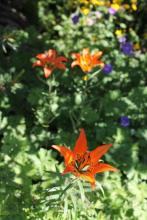
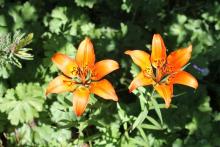



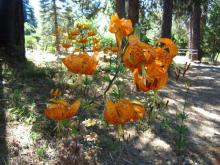
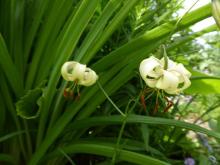
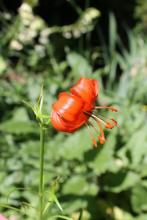
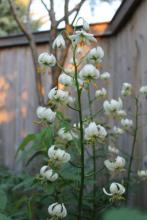
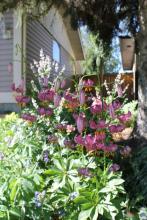
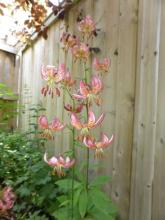
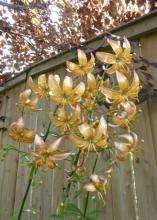






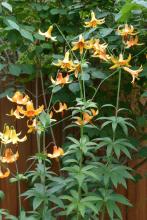
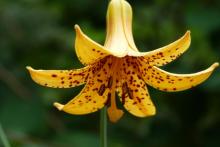
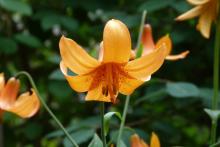
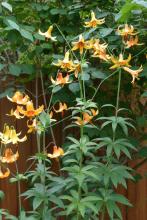
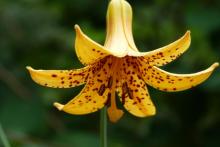
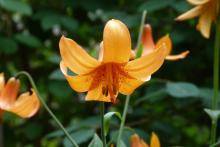




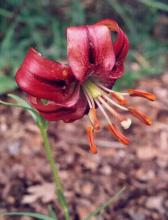
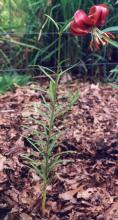
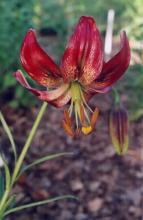



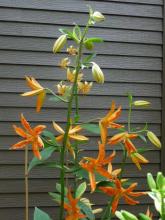

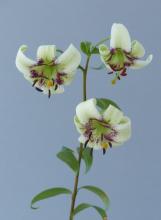

Nice one Fermi
looks over one meter tall ??
Roland